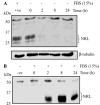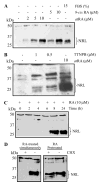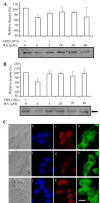Retinoic acid regulates the expression of photoreceptor transcription factor NRL
- PMID: 16854989
- PMCID: PMC1592579
- DOI: 10.1074/jbc.M605500200
Retinoic acid regulates the expression of photoreceptor transcription factor NRL
Abstract
NRL (neural retina leucine zipper) is a key basic motif-leucine zipper (bZIP) transcription factor, which orchestrates rod photoreceptor differentiation by activating the expression of rod-specific genes. The deletion of Nrl in mice results in functional cones that are derived from rod precursors. However, signaling pathways modulating the expression or activity of NRL have not been elucidated. Here, we show that retinoic acid (RA), a diffusible factor implicated in rod development, activates the expression of NRL in serum-deprived Y79 human retinoblastoma cells and in primary cultures of rat and porcine photoreceptors. The effect of RA is mimicked by TTNPB, a RA receptor agonist, and requires new protein synthesis. DNaseI footprinting and electrophoretic mobility shift assays (EMSA) using bovine retinal nuclear extract demonstrate that RA response elements (RAREs) identified within the Nrl promoter bind to RA receptors. Furthermore, in transiently transfected Y79 and HEK293 cells the activity of Nrl-promoter driving a luciferase reporter gene is induced by RA, and this activation is mediated by RAREs. Our data suggest that signaling by RA via RA receptors regulates the expression of NRL, providing a framework for delineating early steps in photoreceptor cell fate determination.
Figures





Similar articles
-
Transformation of cone precursors to functional rod photoreceptors by bZIP transcription factor NRL.Proc Natl Acad Sci U S A. 2007 Jan 30;104(5):1679-84. doi: 10.1073/pnas.0605934104. Epub 2007 Jan 22. Proc Natl Acad Sci U S A. 2007. PMID: 17242361 Free PMC article.
-
The basic motif-leucine zipper transcription factor Nrl can positively regulate rhodopsin gene expression.Proc Natl Acad Sci U S A. 1996 Jan 9;93(1):191-5. doi: 10.1073/pnas.93.1.191. Proc Natl Acad Sci U S A. 1996. PMID: 8552602 Free PMC article.
-
Sumoylation of bZIP transcription factor NRL modulates target gene expression during photoreceptor differentiation.J Biol Chem. 2010 Aug 13;285(33):25637-44. doi: 10.1074/jbc.M110.142810. Epub 2010 Jun 15. J Biol Chem. 2010. PMID: 20551322 Free PMC article.
-
Neural retina leucine-zipper regulates the expression of Ppp2r5c, the regulatory subunit of protein phosphatase 2A, in photoreceptor development.FEBS J. 2010 Dec;277(24):5051-60. doi: 10.1111/j.1742-4658.2010.07910.x. Epub 2010 Nov 16. FEBS J. 2010. PMID: 21078119
-
Feedback induction of a photoreceptor-specific isoform of retinoid-related orphan nuclear receptor β by the rod transcription factor NRL.J Biol Chem. 2014 Nov 21;289(47):32469-80. doi: 10.1074/jbc.M114.605774. Epub 2014 Oct 7. J Biol Chem. 2014. PMID: 25296752 Free PMC article.
Cited by
-
Evaluation of mesenchymal stem cells as an in vitro model for inherited retinal diseases.Front Cell Dev Biol. 2024 Nov 15;12:1455140. doi: 10.3389/fcell.2024.1455140. eCollection 2024. Front Cell Dev Biol. 2024. PMID: 39620144 Free PMC article. Review.
-
Protein Profiling of WERI-RB1 and Etoposide-Resistant WERI-ETOR Reveals New Insights into Topoisomerase Inhibitor Resistance in Retinoblastoma.Int J Mol Sci. 2022 Apr 6;23(7):4058. doi: 10.3390/ijms23074058. Int J Mol Sci. 2022. PMID: 35409416 Free PMC article.
-
Fgf8 Expression and Degradation of Retinoic Acid Are Required for Patterning a High-Acuity Area in the Retina.Dev Cell. 2017 Jul 10;42(1):68-81.e6. doi: 10.1016/j.devcel.2017.05.024. Epub 2017 Jun 22. Dev Cell. 2017. PMID: 28648799 Free PMC article.
-
Immunocytochemical Profiling of Cultured Mouse Primary Retinal Cells.J Histochem Cytochem. 2017 Apr;65(4):223-239. doi: 10.1369/0022155416689675. Epub 2017 Feb 2. J Histochem Cytochem. 2017. PMID: 28151698 Free PMC article.
-
Increasing cell culture density during a developmental window prevents fated rod precursors derailment toward hybrid rod-glia cells.Sci Rep. 2023 Apr 13;13(1):6025. doi: 10.1038/s41598-023-32571-y. Sci Rep. 2023. PMID: 37055439 Free PMC article.
References
Publication types
MeSH terms
Substances
Grants and funding
LinkOut - more resources
Full Text Sources
Other Literature Sources
Molecular Biology Databases

